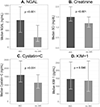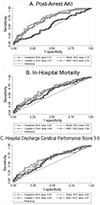Kidney-specific biomarkers for predicting acute kidney injury following cardiac arrest
- PMID: 37499974
- PMCID: PMC10529996
- DOI: 10.1016/j.resuscitation.2023.109911
Kidney-specific biomarkers for predicting acute kidney injury following cardiac arrest
Abstract
Aim: To evaluate the performance of kidney-specific biomarkers (neutrophil gelatinase-associated lipocalin (NGAL), kidney injury molecule-1 (KIM-1), and cystatin-C) in early detection of acute kidney injury (AKI) following cardiac arrest (CA) when compared to serum creatinine.
Methods: Adult CA patients who had kidney-specific biomarkers of AKI collected within 12 h of return of spontaneous circulation (ROSC) were included. The association between renal biomarker levels post-ROSC and the development of KDIGO stage III AKI within 7 days of enrollment were assessed as well as their predictive value of future AKI development, neurological outcomes, and survival to discharge.
Results: Of 153 patients, 54 (35%) developed stage III AKI within 7 days, and 98 (64%) died prior to hospital discharge. Patients who developed stage III AKI, compared to those who did not, had higher median levels of creatinine, NGAL, and cystatin-C (p < 0.001 for all). There was no statistically significant difference in KIM-1 between groups. No biomarker outperformed creatinine in the ability to predict stage III AKI, neurological outcomes, or survival outcomes (p > 0.05 for all). However, NGAL, cystatin-C, and creatinine all performed better than KIM-1 in their ability to predict AKI development (p < 0.01 for all).
Conclusion: In post-CA patients, creatinine, NGAL, and cystatin-C (but not KIM-1) measured shortly after ROSC were higher in patients who subsequently developed AKI. No biomarker was statistically superior to creatinine on its own for predicting the development of post-arrest AKI.
Keywords: Creatinine; Cystatin-C; KIM-1; NGAL; Post-arrest; Renal biomarkers.
Copyright © 2023 Elsevier B.V. All rights reserved.
Conflict of interest statement
Declaration of Competing Interest The authors declare that they have no known competing financial interests or personal relationships that could have appeared to influence the work reported in this paper.
Figures



References
Publication types
MeSH terms
Substances
Grants and funding
LinkOut - more resources
Full Text Sources
Medical
Miscellaneous

